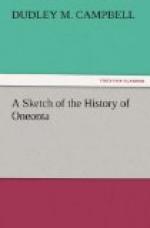“We soon saw the ill effects of Windecker’s rum. The Indians began to drink and some of our party were the worse for it. We perceived what was coming.
“June 1st, 1753, is with me a memorable day, and for forty years and more has not passed unnoticed. We got off as silently as we could with ourselves and effects. Some went by water and others by land, with the horses. I was with the land party. The Indians, half intoxicated, were outrageous, and pursued both the party by water, in which was Mr. Woodbridge, and the party by land. One came so near us as with his club to strike at us, and he hit one of our horses. We hastened. Neither party met till we arrived at Wauteghe [the name of the Indian village at the mouth of the Otego creek] at which had been an Indian village, where were a few fruit trees and considerable cleared land, but no inhabitants. Here, being unmolested and secure, we all refreshed ourselves. But Pallas was the worse for his rum; was so refractory that Mr. Ashley’s hired man, who had been in the canoe with him, was afraid. I reproved him; got into the canoe to keep him in order; was young and inexperienced; knew not much of Indians, nor much of mankind; whereby I endangered my life.”
In 1763, Rev. Mr. Wheelock made application to Gen. Amherst for a land grant in the following words: “That a tract of land, about fifteen or twenty miles square, or so much as shall be sufficient for four townships, on the west side of Susquehanna river, or in some other place more convenient, in the heart of the Indian country, be granted in favor of this school. The said townships be peopled with a chosen number of inhabitants of known honesty, integrity, and such as love and will be kind to, and honest in their dealings with Indians.
“That a thousand acres of, and within said grant be given to this school; part of it to be a college for the education of missionaries, interpreters, school-masters, etc.; and part of it a school to teach reading, writing, etc. And that there be manufactures for the instruction of both males and females, in whatever shall be useful and necessary in life, and proper tutors, masters and mistresses be provided for the same.”
CHAPTER II.
During the war for independence, the Susquehanna valley below Schenevus creek was the lurking place of Indians and Tories, who, from this secluded territory, made many and frequent inroads upon the settlements on the Schoharie and Charlotte. Owing to the remoteness of this section and the weak condition of the frontiersmen, the trail of the retreating savages was seldom followed to any considerable distance and consequently but little knowledge concerning the valley was derived by the settlers at the former points until the restoration of peace.
In 1770, an extensive tract of land was granted to Sir William Johnson and others, a large part of which lies within the limits of the town of Oneonta. This tract lies on both sides of the Susquehanna river, both above and below the Otego creek. It is supposed the first settlement within the town was made upon this patent.[A] It contained 26,000 acres.




